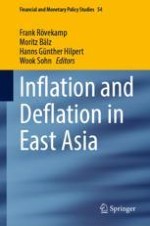2023 | OriginalPaper | Chapter
7. Why Has There Been No Inflation in Japan?
Authors : Markus Heckel, Franz Waldenberger
Published in: Inflation and Deflation in East Asia
Publisher: Springer Nature Switzerland
Activate our intelligent search to find suitable subject content or patents.
Select sections of text to find matching patents with Artificial Intelligence. powered by
Select sections of text to find additional relevant content using AI-assisted search. powered by
